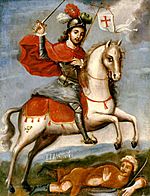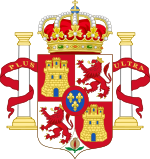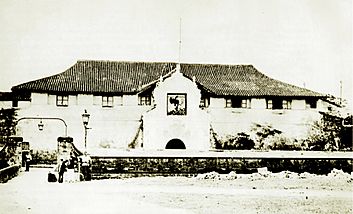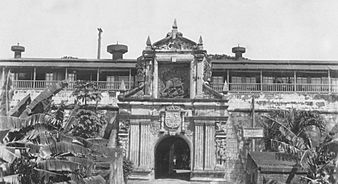Fort Santiago facts for kids
Quick facts for kids Fort Santiago |
|
|---|---|
|
Moóg ng Santiago
|
|
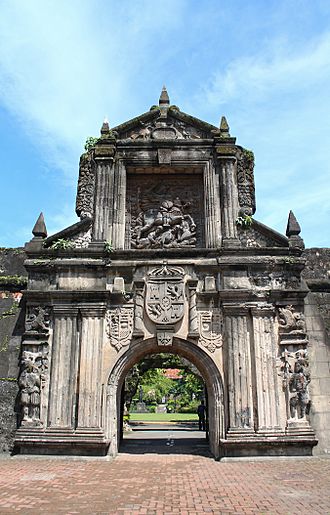
The reconstructed main gate of Fort Santiago
|
|
| General information | |
| Type | Bastioned fort |
| Architectural style | Italian-Spanish school of fortification |
| Location | along the Pasig River |
| Town or city | Intramuros |
| Country | Philippines |
| Coordinates | 14°35′42″N 120°58′10″E / 14.59500°N 120.96944°E |
| Named for | Saint James the Great |
| Construction started | 1590 |
| Completed | 1593 |
| Renovated | 1733 |
| Dimensions | |
| Other dimensions | 2,030 feet (620 m) perimeter |
| Technical details | |
| Structural system | Masonry |
| Design and construction | |
| Architect | Gómez Pérez Dasmariñas (1590) Fernándo Valdés y Tamon (1730s) |
| Structural engineer | Leonardo Iturriano |
| Designations | National Historical Landmark |
Fort Santiago is an old castle-like fortress built in 1571 by the Spanish in Manila, Philippines. It's located inside Intramuros, which is a walled city. This fort was very important for defending Manila.
Today, Fort Santiago is one of the most famous historical places in Manila. Many people were held prisoner here during the time of the Spanish Empire and World War II. José Rizal, a national hero of the Philippines, was even imprisoned here before he was executed in 1896. You can visit the Rizal Shrine inside the fort to see things that belonged to him. There are even bronze footsteps on the ground showing his last walk from his cell to where he was executed.
The fort is also close to the Manila Cathedral and the Palacio del Gobernador, which means "Governor's Palace."
Contents
Exploring Fort Santiago
Fort Santiago was named after Saint James, who is called Santiago in Spanish. He is the patron saint of Spain. The fort is built at the mouth of the Pasig River. It was the main defense for the Spanish government when they ruled the Philippines. For 333 years, it was a key fort for the spice trade between Asia, the Americas, and Europe. The famous Manila Galleon trade, which sailed to Acapulco, Mexico, started from Fort Santiago.
The fort is shaped almost like a triangle and has walls that stretch about 2,030 feet (620 m) around. On the side facing the city, there's a strong wall with two half-bastions (parts of the wall that stick out). A moat (a deep, wide ditch filled with water) connected to the river separated the fort from the city. There was also a special tower called Santa Barbara with three places for cannons, looking out towards the sea, the entrance, and the river.
The walls of the fort are about 22-foot (6.7 m) high and 8 feet (2.4 m) thick. The main entrance gate is 40 feet (12 m) high and faces the city. Inside the fort, there were guard stations, barracks for soldiers, and living quarters for the warden. There were also storage rooms, a chapel, a place for gunpowder, and sentry towers.
Fort Santiago's Past
Before the Spanish arrived, the area where Fort Santiago stands was a fort made of wood and earth. It had bronze cannons and belonged to Rajah Matanda, a local leader. In 1570, Spanish soldiers led by Martin de Goiti fought with the local people and destroyed this fort. The Spanish then started building their own fort, Fuerte de Santiago, after they made Manila the capital of the Philippines on June 24, 1571.
The first Spanish fort was also made of palm logs and earth. Much of it was destroyed when Chinese pirates, led by Limahong, attacked the city. After a big fight, the Spanish, led by Juan de Salcedo, drove the pirates away.
The construction of Fort Santiago with strong stone walls began in 1590 and was finished in 1593. The stones used were volcanic rock from Guadalupe. The fort had strong walls and an open platform for cannons called the battery of Santa Barbara. In 1714, the fancy main gate of Fort Santiago was built. Later, in 1880, a big earthquake damaged parts of the fort.
British Takeover
In 1762, British forces invaded and captured Manila, including Fort Santiago. The fort became a base for the Royal Navy until 1764, when the British and Spanish agreed to stop fighting.
American Rule
On August 13, 1898, the American flag was raised over Fort Santiago. This marked the beginning of American rule in the Philippines. The fort became the headquarters for the U.S. Army. The Americans made some changes, like draining the moats around the fort and turning the grounds into a golf course!
World War II Events
During World War II, the Japanese Imperial Army took over Fort Santiago. They used its prisons and dungeons to hold hundreds of prisoners. Many prisoners died there, especially near the end of the war during the Manila massacre. The fort was badly damaged by American and Filipino military attacks during the Battle of Manila in February 1945. Sadly, about 600 American prisoners of war died from lack of air or food in the crowded dungeons of Fort Santiago.
Fort Santiago Today
Today, Fort Santiago is a historical park. It includes the fort, its strong walls, and the old prison dungeons. The park also has Plaza Moriones and other old ruins. Inside the park, you can find the Rizal Shrine, which has items belonging to José Rizal.
The fort is now used for many things. Some areas are perfect for outdoor plays, picnics, and walks. The Intramuros visitors center gives information about all the interesting places in the walled city.
Keeping the Fort Safe
After being destroyed in World War II, Fort Santiago was named a Shrine of Freedom in 1950. The Philippine government started restoring it in 1953. Since 1992, the Intramuros Administration has been in charge of rebuilding, taking care of, and managing the fort.
Images for kids
See also
 In Spanish: Fuerte de Santiago (Manila) para niños
In Spanish: Fuerte de Santiago (Manila) para niños


